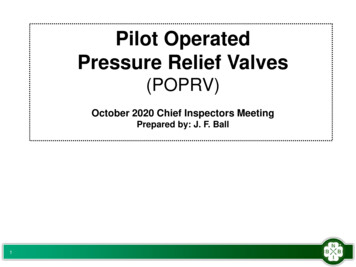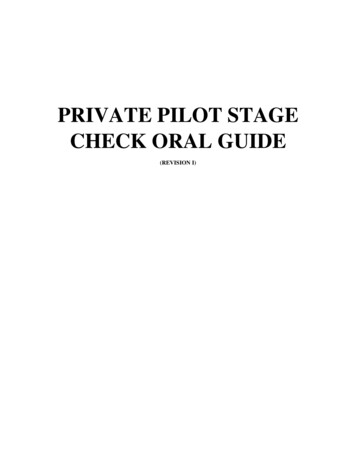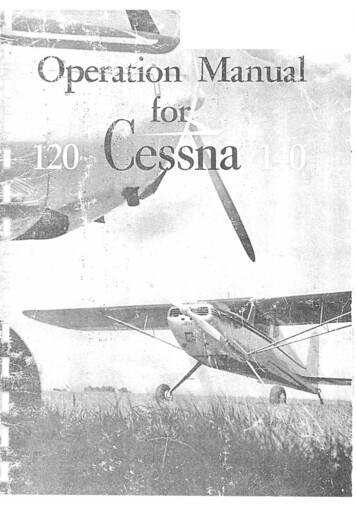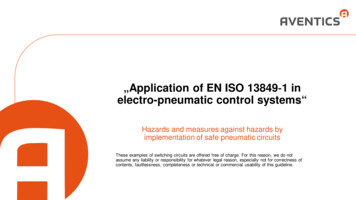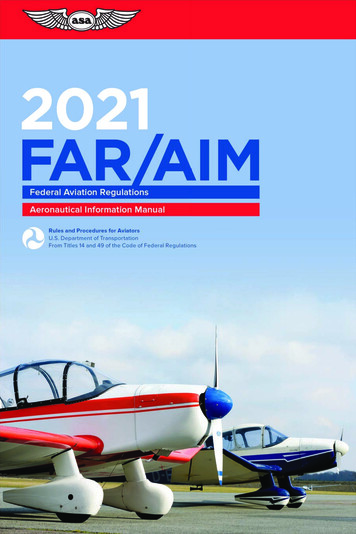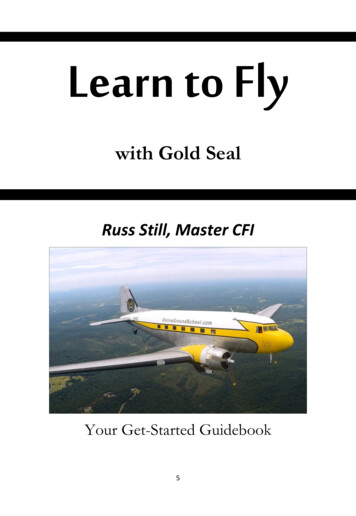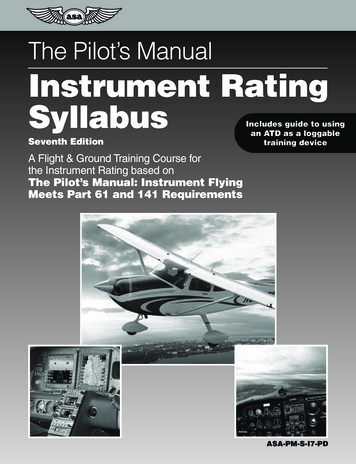
Transcription
168FALL 2002PREVENTIVE CARDIOLOGYCLINICAL STUDIESA Controlled Pilot Study of StressManagement Training of ElderlyPatients With Congestive Heart FailureFrederic Luskin, PhD; Megan Reitz, BA; Kathryn Newell, MA; Thomas Gregory Quinn, MD;William Haskell, PhDThe purpose of this study was to evaluate the effectof stress management training on quality of life,functional capacity, and heart rate variability in elderly patients with New York Heart Association classI–III congestive heart failure (CHF). While substantial research exists on stress management training forpatients with coronary heart disease, there are fewdata on the value of psychosocial training on patients with CHF. Thirty-three multiethnic patients(mean age, 66 9 years) were assigned throughincomplete randomization to one of two treatmentgroups or a wait-listed control group. The 14 participants who completed the treatment attended eighttraining sessions during a 10-week period. The training consisted of 75-minute sessions adapted from theFreeze-Frame stress management program developedby the Institute of HeartMath. Subjects were assessedat baseline and again at the completion of the training. Depression, stress management, optimism, anxiety, emotional distress, and functional capacitywere evaluated, as well as heart rate variability.Significant improvements (p 0.05) were noted inperceived stress, emotional distress, 6-minute walk,and depression, and positive trends were noted ineach of the other psychosocial measures. The 24-hourheart rate variability showed no significant changesin autonomic tone. The authors noted that CHFpatients were willing study participants and theiremotional coping and functional capacity wereenhanced. This program offers a simple and costeffective way to augment medical management ofCHF. Given the incompleteness of CHF medicalmanagement and the exploding interest in compleFrom the Stanford Center for Research in Disease Prevention,Stanford University School of Medicine, Palo Alto, CAAddress for correspondence:Frederic Luskin, PhD, Stanford Center for Research inDisease Prevention, 730 Welch Road, Suite B, Palo Alto,CA 94304-1583E-mail: fredl@stanford.eduManuscript received July 10, 2001;accepted September 4, 2001mentary medical intervention, it seems imperativethat further work in psychosocial treatment beundertaken. (Prev Cardiol. 2002;5:168–172, 176) 2002CCHF, Inc.ongestive heart failure (CHF) is the only majorcardiovascular disorder that is increasing in incidence, prevalence, and overall mortality. Recent studies estimate the prevalence of CHF at almost 5 millionpersons in the United States, leading to hospitalizationof 900,000 patients each year.1 Improvements in survival after myocardial infarction, better managementof diabetes and hypertension, and an increase in theaging population have contributed to the rise in CHF.2The hallmark of CHF is exercise intolerance and activity restriction, most commonly due to symptoms ofdyspnea and fatigue. These symptoms are debilitatingand result in low functional capacity and progressivephysical disability, often requiring intensive medicalmanagement, follow-up, and hospitalization.In addition to physical decline, these patients oftenreport depressed mood, anxiety, and increased hostility.3 A structured interview with 60 hospitalized CHFpatients (aged 70 years) showed that 17% of the participants met the Revised Diagnostic and StatisticalManual of Mental Disorders (DSM III) criteria formajor depression. The patients who were depressedrequired a greater number of inpatient hospital daysand, at 1 year, showed greater mortality.4Patients with CHF are known for very high mortality rates, as well as the highest hospital readmissionrates of all patient populations.5 This may be partlydue to the psychosocial consequences of the diseaseprocess, which includes behavioral restrictions, as wellas comorbid depression and anxiety. A study that evaluated quality of life of CHF patients found no significant relationship between a patient’s cardiac ejectionfraction and any quality of life measure.2 However,self-reported functional status, depression, and hostility were significant indicators of quality of life amongthese patients.
FALL 2002Recent studies have shown that sympathetic activation is one of the hallmark physiologic abnormalities inCHF. Circulating catecholamine levels have been associated with increased severity of disease and unfavorable prognosis.6 As a result of these studies, the “neurohormonal” hypothesis has emerged as the leadingparadigm for understanding the progression of CHF.7Pharmacologic therapies that alter autonomic balance, such as angiotensin-converting enzyme inhibitorsand β blocking agents, have become standard therapyfor CHF patients.8 However, noncompliance can be asignificant problem in pharmacologic treatment.Monane et al.9 noted that among elderly CHF patientson digoxin, only 10% were completely compliant withthe prescribed regimen over the course of a year. Theuse of β blockers elicits better adherence, yet medicalmanagement of CHF is still incomplete.10 Sullivan andHawthorne11 reviewed the nonpharmacologic interventions for CHF. They cite the effectiveness of longterm aerobic exercise conditioning programs and makethe case for offering psychological and biobehavioralinterventions to enhance outcome and quality of life.To test their hypothesis, they examined the effect ofstructured nursing care for CHF patients in order toreduce readmission rates and improve quality of life.4The study results showed that patients with CHF experienced major mood disturbances greater than thosereported by other cardiac patients. This mood disruption was directly related to patients’ quality of life andhighlighted the need for concurrent psychosocial intervention. Interestingly, this study found exercise tolerance to be unrelated to patients’ ejection fractions butrelated to quality of life.To date, there are two studies that included a psychosocial intervention as an aspect of a clinical trial. Asone arm of a study, CHF patients were offered anintervention that included exercise training, structuredcognitive therapy, and dietary training. This intervention improved functional capacity, body weight, andmood state.12 The second13 was a pilot study in whichNew York Heart Association (NYHA) class II IV CHFpatients taught the Freeze-Frame14 stress managementprogram showed significant improvement in copingwith stress and a trend toward increased self-confidence related to their physical fitness. Previous research had shown the short-term positive effects ofFreeze-Frame to include enhancement of heart ratevariability and modification of sympathetic arousal inhealthy volunteers.15,16 This study attempted to measure participants’ autonomic balance, but the severity ofNYHA class III IV CHF prevented adequate recordingof 24-hour heart rate variability. Compromised heartrate variability was the factor that best predicted earlydeath from progressive heart failure.17Stress management and relaxation training are psychosocial practices that can reduce sympathetic arousal. Research shows the usefulness, in both primary andsecondary prevention, of stress management trainingin patients with coronary artery disease.18 This currentstudy builds upon the authors’ previous study throughPREVENTIVE CARDIOLOGYrecruiting and randomization of a larger number ofparticipants with less severe CHF.RESEARCH DESIGN AND METHODSParticipantsThe initial study sample consisted of 13 men and20 women with an average age of 66 9 years.Thirteen participants were middle-class AngloAmericans, with one Asian American woman, andwere invited to participate by the nurse at a localcardiac rehabilitation facility. Nineteen participantswere inner city, low socioeconomic status AfricanAmerican, Asian American, or Latino patients, andwere invited to participate by their cardiologists.Subjects had been diagnosed as having NYHAclass I to very early class III CHF at least 3 monthspreviously and had been on a stable medication regimen for at least 1 month. A cardiologist evaluatedeach patient’s medical file and certified each participant as eligible for the study. Stanford University’sInstitutional Review Board approved this project.Participants were assigned to either of two treatment groups or to the wait-listed control groupthrough incomplete randomization. Full randomization was attempted, but because only one class washeld per location, four participants in the treatmentgroup could not make the training sessions and becamecontrol group participants. Subsequently, five controlgroup members were assigned to the treatment groups.Control group members were invited to attend a 1-daytraining at the completion of the intervention.InterventionAll participants received the same 10 hours of trainingoffered during eight weekly 75-minute sessions spreadover 10 weeks. The two treatment groups followed thesame topical outline that was taught by one of theauthors (Frederic Luskin), a licensed psychotherapist.The training was primarily didactic in nature, with anemphasis on guided practice of the techniques. A limited amount of time was set aside for participant sharing of personal experience. After each session, participants were given practice assignments for the week.The stress management techniques taught wereFreeze-Frame, Heart Lock-in, Appreciation and Carevs. Overcare. Freeze-Frame is the basic stress management technique and starts with the conscious shiftingof attention from a stressful experience to the areaaround one’s heart. After taking a few slow, deepbreaths into the area around the heart, one’s attentionis drawn to a visualization or memory of a positiveemotion, such as care or love. Then the feeling generated by that positive emotion is held in the area aroundthe heart. Heart Lock-in is an extended Freeze-Frame,while Appreciation is learning to focus attention onpositive experiences. Care is distinguished fromOvercare. Overcare is defined as the tendency to wantsomething or someone so much that the extra effortand/or anxiety obscures the positive experience of careand leads to distress.169
170FALL 2002PREVENTIVE CARDIOLOGYThe class outline was as follows:1. Orientation and class overview. Review researchon the effectiveness of practice of Freeze-Frame.Guided practice in Freeze-Frame.2. Review of research on effectiveness of stress management in cardiovascular disease. Review ofwhat stress does to the body. Review of FreezeFrame. Guided practice in Heart Lock-in.3. Discussion of stress management practice as aform of complementary medicine. Discussion ofimportance of self-care. Presentation of conceptof Appreciation. Guided practice in Freeze-Frame.4. Discussion of secondary gain (behavior that onthe surface appears unproductive has personallyrelevant reason for continuation). Discussion ofthe difficulty in changing patterns of response.Brainstorming for suggestions. Guided practicein Heart Lock-in.5. Practice in thinking of ways to include FreezeFrame in daily life. Teaching of other simplestress management tips, such as deep breathingand taking a moment before making decisions.Guided practice in Heart Lock-in.6. Discussion of Care vs. Overcare and implicationsfor stress management. Presentation of the concept of finding the Care rather than the Overcarein each situation one encounters. Guided practicein Heart Lock-in.7. Presentation of mental health as partly the choiceof how one responds. Emphasis on decisions thatprimarily manifest either Care or Overcare.Teaching, through class examples, that sufferingis the result of Overcare crowding out Care.Guided practice in Heart Lock-in.8. Review of course material. Reminders for futurepractice, creation of an ongoing practice routinethat does not vary, and emphasis on continuedpractice. Participant feedback on training.At the conclusion of each class period, participantswere given homework practice suggestions. Beginningwith the second session, each participant was asked todo one Heart Lock-in per day for 15 minutes. Startingwith session 4, each participant was asked to do twoHeart Lock-ins per day. In addition, starting with thefirst session, participants were asked to do at least threeFreeze-Frames per day, as well as look for opportunities during the day to practice Freeze-Frame.MeasuresAll measures were administered 1 2 weeks before thetraining began (pretest) and 1 2 weeks after the training ended (post-test).1. Geriatric Depression Scale: measures participant’s level of negative affect.192. Perceived Stress Scale: measures participant’s perceived level of stress and ability to cope.203. Life Orientation Test: measures subject’s level ofpositive expectation or optimism.214. State Trait Anxiety Inventory: measures stable ordispositional expression of anxiety.225. Medical Outcome Survey Questions 3 and 9:two of the multi-item self-report questions wereevaluated that ask participants to rate their ability to complete basic activities and the quality oftheir emotional experience.236. Minnesota Living with Heart Failure: a quality of life measure evaluating the degree towhich CHF interferes with the completion ofnormal life tasks.247. Self-report physical fitness: participants areasked to rate their confidence in their physicalability.258. Six-minute walk: participants are measured tosee how far they can walk in 6 minutes.9. Systolic blood pressure: pressure was taken threetimes with 5-minute intervals and the averagepressure was utilized for comparison.10. Heart rate variability (HRV): evaluates changes inautonomic tone through 24-hour Holter monitoring, with use of the following indices26:Time domain: Mean heart rate in beats per minute SDNN: standard deviation of the normal-to-normal (NN) interval in milliseconds; measures overall HRV SDNN index: the mean of the 5-minute standarddeviation of NN intervals calculated over 24hours; measures overall HRV RMS-SD: the square root of the mean squareddifferences of successive NN intervals; a measureof vagal tone 24-Hour triangle index: total number of all NNintervals divided by the maximum NN interval; ameasure of overall HRV frequency domain Low frequency: variance in the 0.04 0.15-Hzrange; a measure of both parasympathetic andsympathetic tone High frequency: variance in the 0.15 4.00-Hzrange; a measure of vagal tone 5-Minute total power: variance of all 5-minuteintervals; a measure of overall HRV Total power: variance of all NN intervals; a measure of overall HRVRESULTSData were available for 29 subjects for pre- and posttests. Two treatment group subjects dropped out due toillness and two control subjects lost interest in the studyand did not complete the post-tests. The subjects whowere not available for post-testing were not significantly different from the other subjects. The SPSS (version 9) (SPSS Inc., Chicago, IL) general linear modelwas used to evaluate changes in all dependent variablesbetween the control and treatment groups over time.The results of the psychosocial, functional capacity,and blood pressure recordings are reported in Table I.The quality of the 24-hour Holter recordings wasgood and the participants complied without fail withthe monitoring. However, autonomic balance couldbe evaluated in only 23 of the 29 participants both
PREVENTIVE CARDIOLOGYFALL 2002pre- and post-test, due to excessive ectopic activity insix patients: four of the patients had atrial fibrillation,one had sinus arrhythmia, and one had an excessivenumber of ectopic ventricular beats. The results ofthe HRV monitoring are reported in Table II.On measures of psychosocial functioning, significant improvement in the treatment group was notedon the Geriatric Depression Scale (p 0.02), PerceivedStress Scale (p 0.001), and the Medical OutcomeSurvey question 9 that evaluated emotional status(p 0.001). On the Life Orientation Test, State TraitAnxiety Scale, Medical Outcome Survey question 3,Minnesota Living with Heart Failure, and the PhysicalFitness Scale, positive trends were noted. On a measure of functional capacity—the 6-minute walk—significant improvement was observed (p 0.02). Treatmentgroup members walked, on average, 175 feet further atpost-test than at pretest. No change was seen in systolicblood pressure.No significant treatment-associated changes occurred in HRV. There was a slight increase in SDNN andthe SDNN index in the treatment group, coupledwith slight decreases in SDNN and the SDNN indexin the control group. This same trend was noted inRMS-SD, mean heart rate, low frequency variance aswell as total power and 5- min total power. No changewas seen in 24-hour triangle index for the treatmentsubjects, while a slight decrease was seen in the control group. The same pattern appeared for high frequency variance.DISCUSSIONThis controlled pilot study was the authors’ secondattempt to investigate stress management training inpatients with CHF. It was successful in that participantsregularly attended the training, complied with theassessments and reported that the training was bothenjoyable and valuable. The treatment group memberswere able to significantly reduce their stress levels andimprove their ability to cope with stress over thecourse of the training. They made improvement inphysical fitness as evidenced by the increase in distancewalked during a 6-minute walk test. In addition, theysignificantly reduced their level of depression and emotional upset and had positive trends in optimism andCHF disease impact.There were minimal changes in the HRV data, yetmost of the indices showed nominal changes in apositive direction for the treatment group and nominal changes in a negative direction for the controlgroup. These results suggest that a longer intervention (9 months to a year) with greater time spent inpractice (1 hour per day), and investigated with alarger subject pool might show beneficial changes inautonomic balance.Of note is the response of the patients to the training. Attendance was excellent and in post-test debriefings the participants expressed singular appreciationfor the training. Most of them mentioned the lack ofpsychosocial support they experienced for their condition and their frustration at the number of drugsrequired for medical management.The authors wish to emphasize the need for further investigation of stress management for patientswith CHF. As stated, a dearth of information exists inthis area as compared to the substantial research thatexists for patients with coronary artery disease. Thispilot study showed that these patients make goodTable I. Means and Standard Deviations of Dependent Variables at Pre- and Post-TestTREATMENT GROUPN 14PRE(SD)DepressionStressOptimismAnxietyMOS 36-Q3MOS 36-Q9MLHFPF6-Minute walkSystolic BP (mm Hg)8.3 (6.0)25.8 (4.6)21.1 (3.6)40.2 (8.0)21.7 (5.6)24.0 (3.5)30.9 (20.5)24.8 (7.1)1088.0 (360)126.0 (13.5)POST(SD)5.5 (3.0)20.2 (5.6)22.2 (4.0)35.9 (7.1)23.7 (5.4)18.8 (4.1)23.5 (14.8)23.8 (4.2)1241.0 (318)126.0 (17.0)CONTROL GROUPN 15PRE(SD)5.3 (6.3)19.1 (8.9)25.0 (4.2)36.4 (9.9)20.4 (5.1)22.6 (6.9)36.9 (22.2)24.5 (6.4)1191.0 (238)125.0 (20.0)P VALUE*POST(SD)6.0 (6.8)20.5 (10.3)24.5 (4.7)36.6 (11.1)19.8 (5.5)22.8 (6.0)35.4 (21.8)24.6 (5.9)1171.0 (277)121.0 (21.2)0.020.001–––0.000––0.02–*p for difference in the change pre- to post-test between the treatment and control groups; Depression GeriatricDepression Scale; Stress Perceived Stress Scale; Optimism Life Orientation Test; Anxiety State Trait AnxietyScale; MOS 36-Q3 Medical Outcome Survey Question 3—Basic Activities; MOS 36-Q9 Medical Outcome SurveyQuestion 9—Emotional Distress; MLHF Minnesota Living with Heart Failure; PF perceived physical fitness;6-Minute walk distance covered in 6 minutes measured in feet; BP blood pressure171
172FALL 2002PREVENTIVE CARDIOLOGYTable II. Measures of Heart Rate Variability at Pre- and Post-TestTREATMENT GROUPN 14PRE(SD)Time domainMean heart rateSDNNSDNN indexRMS-SD24-Hr triangle indexFrequency domainHigh frequencyLow frequency5-Minute total powerTotal powerCONTROL GROUPN 9POST(SD)PRE(SD)POST(SD)72.2 (10.4)100.7 (38.0)41.0 (13.9)23.9 (6.6)29.7 (11.9)71.7 (10.2)104.2 (44.6)43.5 (18.5)25.4 (9.8)29.5 (14.2)75.6 (10.2)99.0 (27.6)44.1 (17.5)32.0 (24.7)30.9 (11.0)78.1 (12.4)95.4 (21.7)42.3 (17.4)30.0 (21.2)29.5 (9.1)4.55 (0.7)5.53 (0.9)7.11 (0.8)9.10 (0.8)4.54 (0.8)5.68 (1.0)7.19 (0.9)9.15 (0.9)4.90 (1.2)5.58 (0.9)7.29 (0.9)9.10 (0.6)4.67 (1.3)5.51 (0.9)7.10 (0.9)9.05 (0.5)SDNN standard deviation of the normal-to-normal (NN) interval in milliseconds; measures overall heart ratevariability; SDNN index the mean of the 5-minute standard deviation of NN intervals calculated over 24 hours;measures overall heart rate variability; RMS-SD the square root of the mean squared differences of successive NNintervals; a measure of vagal tonestudy participants and that their psychosocial copingand functional capacity can be enhanced throughtraining. This intervention was inexpensive, and if theresults hold up in future studies, can be expected toimprove the quality of life in CHF patients.Considering the incompleteness of medical management of this disease, and the exploding interest incomplementary medical interventions, it seemsimperative that further work in psychosocial adjunctive treatment be undertaken.LIMITATIONSThe validity of the study results are attenuatedbecause of the lack of full randomization. Whilescheduling was the primary reason to switch participants from one group to another there is no way toknow the effect the incomplete randomization hadon the outcome. This study also combined the datafrom two groups of participants with divergentsocioeconomic status and life experience. About 60%of the participants were from an inner city neighborhood and were largely African American and Latino.The other participants were Anglo Americans from amiddle class suburb. Therefore, there was insufficientdata to complete separate analyses so it is not clearwhether the relaxation training intervention is equally as effective for members of the different socioeconomic status and ethnic groups. Finally, a follow-upassessment would help to determine if the positiveresults seen from the intervention were lasting orwhether CHF patients require continued attention tomaintain quality-of-life gains.Acknowledgment: The preparation of this manuscript was supportedby a grant from the Office of Alternative Medicine, NationalInstitutes of Health (grant number AG43558).REFERENCES1 American Heart Association. 1999 Heart and Stroke Statistical Update. Dallas, Texas: American Heart Association;1998.2 Anonymous. Mortality from congestive heart failure—UnitedStates, 1980–1990. MMWR Morb Mortal Wkly Rep. 1994;43:77–81.3 Dracup K, Walden J, Stevenson L, et al. Quality of life inpatients with advanced heart failure. J Heart Lung Transplant.1992;11(2 pt 1):273–279.4 Freedland KE, Carney R, Rich MW, et al. Depression in elderlypatients with congestive heart failure. J Geriatr Psychiatry.1991;24(1):59–71.5 Hawthorne MH, Hixon ME. Functional status, mood disturbance, and quality of life in patients with heart failure. ProgCardiovasc Nurs. 1994;9(1):22–32.6 Maniolis AJ, Olympios C, Sifaki M, et al. Suppressing sympathetic activation in congestive heart failure, a new therapeuticstrategy. Hypertension. 1995;26:719–724.7 Bristow M. Mechanism of action of beta-blocking agents inheart failure. Am J Cardiol. 1997;80(11A):26L–40L.8 Heart Failure Society of America. HFSA Guidelines for themanagement of patients with heart failure due to left ventricular systolic dysfunction-pharmacologic approaches: recommendations for pharmacologic therapy. Congest Heart Fail.2000;6(1):16–23.9 Monane M, Bohn RL, Gurwitz JH, et al. Noncompliance withcongestive heart failure therapy in the elderly. Arch Intern Med.1988;154:433–437.10 Khan NU, Movahed A. Role of beta blockers in congestive heartfailure. Congest Heart Fail. 2000;6(6):299–312.11 Sullivan MJ, Hawthorne MH. Nonpharmacologic interventionsin the treatment of heart failure. J Cardiovasc Nurs.1996;10(2):47–57.12 Kostis JB, Rosen RC, Cosgrove NM, et al. Nonpharmacologictherapy improves functional and emotional status in congestiveheart failure. Chest. 1994;106(4):996–1001.13 Luskin FM, Newell KA, Haskell W. Stress management trainingof elderly patients with congestive heart failure: pilot study. PrevCardiol. 1999;2:101–104.14 Childre D. Freeze-frame: A Scientifically Proven Technique forClear Decision Making and Improved Health. Boulder Creek,CA: Planetary Publications; 1998.continued on page 176
176PREVENTIVE CARDIOLOGY15 Tiller W, McCraty R, Atkinson M. Cardiac coherence: a new,noninvasive measure of autonomic nervous system order.Altern Ther Health Med. 1996;2(1):52–65.16 McCraty R, Atkinson M, Tiller W, et al. The effects of emotionson short-term power spectrum analysis of heart rate variability.Am J Cardiol. 1995;76:1089–1093.17 Nolan J, Batin PD, Andrews R, et al. Prospective study of heartrate variability and mortality in chronic heart failure.Circulation. 1998;98:1622–1630.18 Friedman R, Myers P, Krass S, et al. The relaxation response: use with cardiac patients. In: Allan R, Scheidt S,eds. Heart and Mind: The Practice of Cardiac Psychology.Washington, DC: American Psychological Association;1996;363–385.19 Beck A, Ward C, Mendelson M, et al. An inventory for measuring depression. Arch Gen Psychiatry. 1961;4:561–571.20 Cohen S, Kamarack T, Mermelstein R. A global measure of perceived stress. J Health Soc Behav. 1983;24:385–396.FALL 200221 Scheier MF, Carver CS. Optimism, coping and health: assessment and implications of generalized outcome expectancies.Health Psychiatry. 1985;4(3):219–247.22 Spielberger CD, Gorsch, RL, Lushene RE, et al. Manual for theState Trait Anxiety Inventory (Form Y). Palo Alto, CA:Consulting Psychologists Press; 1983.23 Stewart A, Ware J. Measuring Functioning and Well-Being.Durham, NC: Duke University Press; 1992.24 Rector T, Cohen J. Assessment of patient outcome with theMinnesota Living with Heart Failure Questionnaire: reliabilityand validity during a randomized, double-blind, placebo-controlled trial of pimobendan. Pimobendan Multicenter ResearchGroup. Am Heart J. 1992;124(4):1017–1025.25 Gortner S, Jenkins L. Self-efficacy and activity levels followingcardiac surgery. J Adv Nurs. 1990;15(10):1132–1138.26 Malik M, Bigger J, Camm AJ, et al. Heart rate variability: standards of measurement, physiological interpretation, and clinicaluse. Circulation. 1996;93:1043–1065.
Freeze-Frame, Heart Lock-in, Appreciation and Care vs. Overcare. Freeze-Frame is the basic stress manage-ment technique and starts with the conscious shifting of attention from a stressful experience to the area around one’s heart. After taking a few slow, deep breaths into th

